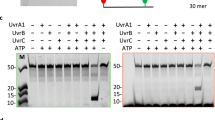Abstract
IN most organisms pyrimidine dimers induced in DNA by ultraviolet light are removed by excision which is initiated by a repair-specific endonuclease that recognises the damage and makes a strand incision adjacent to the dimer1–4. Characterisation of excision-defective mutants of Escherichia coli has shown that in this organism early steps of repair are controlled by the uvrA, uvrB and uvrC genes5. Although uvrA and uvrB mutants seem to be incision defective in vivo6,7, it has not been possible to measure any difference in the amount of ultraviolet-endonuclease activity between crude extracts from mutants and wild-type cells8,9. After partial purification of wild-type or uvrC mutant extracts, however, an ultraviolet endonuclease has been identified which is absent from uvrA and uvrB cells9 (in this communication termed the uvrAB endonuclease). The relevance of these results to whole cells is unclear, because recent experiments with permeable cells have shown that uvrA+B+-dependent strand incision requires adenosine-5′-triphosphate (ATP)10–12, whereas the uvrAB endonuclease is independent of ATP2. The aim of the present investigation was to observe ATP-dependent ultraviolet-endonuclease activity in a cell-free system. We report here the characterisation in crude extracts of an ATP-dependent ultraviolet-endonuclease activity from E. coli and conclude that the activity reflects that the enzyme is essential for repair in whole cells. The activity requires the complementary action of the uvrA+ uvrB+ and uvrC+ products and this has been utilised to establish in vitro assays for the individual products of these genes.
Similar content being viewed by others
References
Setlow, R. B., and Carrier, W. L., Proc. natn. Acad. Sci. U.S.A., 51, 226–231 (1964).
Boyce, R. P., and Howard-Flanders, P., Proc. natn. Acad. Sci. U.S.A., 51, 293–300 (1964).
Howard-Flanders, P., A. Rev. Biochem., 37, 175–200 (1968).
Grossman, L., Braun, A., Feldberg, R., and Mahler, I., A. Rev. Biochem., 44, 19–43 (1975).
Howard-Flanders, P., Boyce, R. P., and Theriot, L., Genetics, 53, 1119–1136 (1966).
Ogawa, H., Shimada, K., and Tomizawa, J., Molec. gen. Genet., 101, 227–244 (1968).
Seeberg, E., and Johansen, I., Molec. gen. Genet., 123, 173–184 (1973).
Takagi, Y., et al., Cold Spring Harb. Symp. quant. Biol, 33, 219–277 (1968).
Braun, A., and Grossman, L., Proc. natn. Acad. Sci. U.S.A., 71, 1838–1842 (1974).
Waldstein, E. A., Sharon, R., and Ben-Ishai, R., Proc. natn. Acad. Sci. U.S.A., 71, 2651–2654 (1974).
Seeberg, E., and Strike, P., J. Bact., 125, 787–795 (1976).
Strike, P., and Emmerson, P. T., Molec. gen. Genet., 130, 39–45 (1974).
Barbour, S. D., and Clark, A. J., Proc. natn. Acad. Sci. U.S.A., 65, 955–961 (1970).
Wickner, W., Brutlag, D., Schekman, R., and Kornberg, A., Proc. natn. Acad. Sci. U.S.A., 69, 965–969 (1972).
Schekman, R., Weiner, J. H., Weiner, A., and Kornberg, A., J. biol. Chem., 250, 5859–5865 (1975).
Morris, C. F., Sinha, N. K., and Alberts, B. M., Proc. natn. Acad. Sci. U.S.A., 72, 4800–4804 (1975).
Kato, T., J. Bact., 112, 1237–1246 (1972).
Seeberg, E., and Rupp, W. D., in Molecular Mechanisms for the Repair of DNA (edit. by Hanawalt, P. C., and Setlow, R. B.), 439–441 (Plenum, New York, 1975).
Wickner, R. B., and Hurwitz, J., Biochem. biophys. Res. Commun., 47, 202–211 (1972).
Author information
Authors and Affiliations
Rights and permissions
About this article
Cite this article
SEEBERG, E., NISSEN-MEYER, J. & STRIKE, P. Incision of ultraviolet-irradiated DNA by extracts of E. coli requires three different gene products. Nature 263, 524–526 (1976). https://doi.org/10.1038/263524a0
Received:
Accepted:
Issue Date:
DOI: https://doi.org/10.1038/263524a0
- Springer Nature Limited
This article is cited by
-
The Nobel Prize in Chemistry 2015: Exciting discoveries in DNA repair by Aziz Sancar
Science China Life Sciences (2016)
-
Nucleotide excision repair in yeast
Current Genetics (1994)
-
Molecular cloning and characterization of the alkB gene of Escherichia coli
Molecular and General Genetics MGG (1985)
-
Cloning of Escherichia coli genes encoding 3-methyladenine DNA glycosylases I and II
Molecular and General Genetics MGG (1984)
-
Properties of enzymes that recognize modified structures in DNA
Journal of Protein Chemistry (1984)





